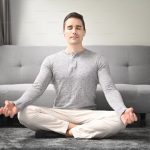We’re starting our series on famous yogis and yoginis with Sri Swami Satchidananda, for the simple reason that his version of the Yoga Sutras of Patañjali has become such a pervasive text in yoga and teacher training courses, and many will be familiar with this guru’s face smiling at you from the cover.
He became a part of hippie culture in America in the ’60s, which is probably the reason he still has such a lasting appeal among Westerners. He hob-nobbed with stars of the stage and screen; in fact he even has a profile on the MTV Artists website, which I don’t think many yogis can attest to.
But before we get on to that, let’s start at the beginning:
Early Life and Lineage
C. K. Ramaswamy Gounder was born in 1914 in South India. After school he studied agriculture and ended up working in the family business. He was always a spiritual man and yoga practitioner, but it was only when he was left widowed with two young children in his late twenties that he decided to trade in his life as a householder for that of an ascetic yogi.
He studied under Ramana Maharishi, and eventually found his way to his guru Swami Sivananda Saraswati, whose tradition he followed for many years. It was from Swami Sivananda Saraswati that he received the name Satchidananda Saraswati. The name Satchidananda or Sat-cit-ānanda is a compound of three Sanskrit words:
- Sat, meaning essence,
- Cit, meaning consciousness and,
- Ānanda, meaning bliss.
Taken together, this term can be understood to be the energetic state of non-duality.
Saraswati is an indicator of the yoga lineage he comes from, kind-of like a surname. The Saraswati lineage was one of the ten monastic orders founded by Adi Sankara, a great Vedantic philosopher. Swami Sivananda is the main figure in this lineage in modern times. More on the rest of these teachers in the weeks to come!
A Modern Yogi
Eventually, Satchidananda was chosen to head up a school of Sivananda’s students in Sri Lanka in the ’50s and ’60s. He was well known, and sometimes ridiculed by traditionalists, for his modern ways. He was seen by Westerners as being approachable and friendly when they were searching for answers to spiritual questions. Westerners were sometimes seen as being impertinent in the way they questioned respected Eastern teachers, but he was patient and helpful in dealing with this. It was also seen as novel that he was happy to drive a car and wear a watch to help him in his work as a yogi and teacher. Thus, the scene was set for him to make an international debut.
International Attention
He visited America in 1966 and eventually received his citizenship. He came to public attention when he presided over a sold-out evening at Carnegie Hall, and seven months later as opening speaker at the 1969 Woodstock festival. Apparently he was called in as a last-minute appearance to cover for someone who didn’t show up.
At the music festival, he sat on a white bedspread surrounded by microphones, and he shared the stage with superstars of their day, Jimi Hendrix, the Who and Crosby, Stills, Nash & Young.
”The whole world is watching you,” he said to the crowd. ”The entire world is going to know what the American youth can do for humanity. America is helping everybody in the material field, but the time has come for America to help the whole world spiritually also.”
He seemed to appeal to the frustrated flower children of the time, and encouraged them to look inwards for answers…
”They are all searching for the necklace that’s around their necks,” he said of the Woodstock generation. Eventually they’ll look in the mirror and see it.”
Constructing His Legacy
After Woodstock, he went on to found the Integral Yoga Institute and Yogaville in America, and was spiritual guru to a number of Hollywood actors and western musicians. In 1986 opened the Light of Truth Universal Shrine at Yogaville in Buckingham, Virginia.
His centres typically hold shrines from many religions, highlighting his belief that all religions lead to God. These centres still run classes and teacher training, and offer comprehensive programmes of study to this day.
“Easeful, Peaceful and Useful”
That was his motto and it reflects his common-sense and pragmatic approach. This is expanded in the main tenets of his Integral Yoga:
“The goal and the birthright of all individuals is to realize the spiritual unity behind the diversity throughout creation and to live harmoniously as members of one universal family”.
This goal is achieved by encouraging and maintaining the natural human conditions:
- a body of optimal health and strength
- senses under total control
- a mind well disciplined, clear, and calm
- an intellect as sharp as a razor
- a will as strong and pliable as steel
- a heart full of unconditional love and compassion
- an ego as pure as crystal
- a life filled with supreme peace, joy and bliss
These are attained by following a yogic lifestyle through adhering to the principles of the eight limbs of yoga. He continued in this way, teaching his lessons around the world until 2002 when he passed away in his homeland of India at the age of 87.
Learn More
He penned a number of books and translations, including Integral Hatha Yoga, To Know Your Self, The Living Gita, The Yoga Sutras of Patañjali, and The Golden Present. As a true modern yogi, there are many videos of Satchidananda available on YouTube, and there is a film about his life called Living Yoga. There are also a lot of resources on the Swami Satchidananda and Yogaville websites.
Have you been influenced by this great yogi? Tell us more!













